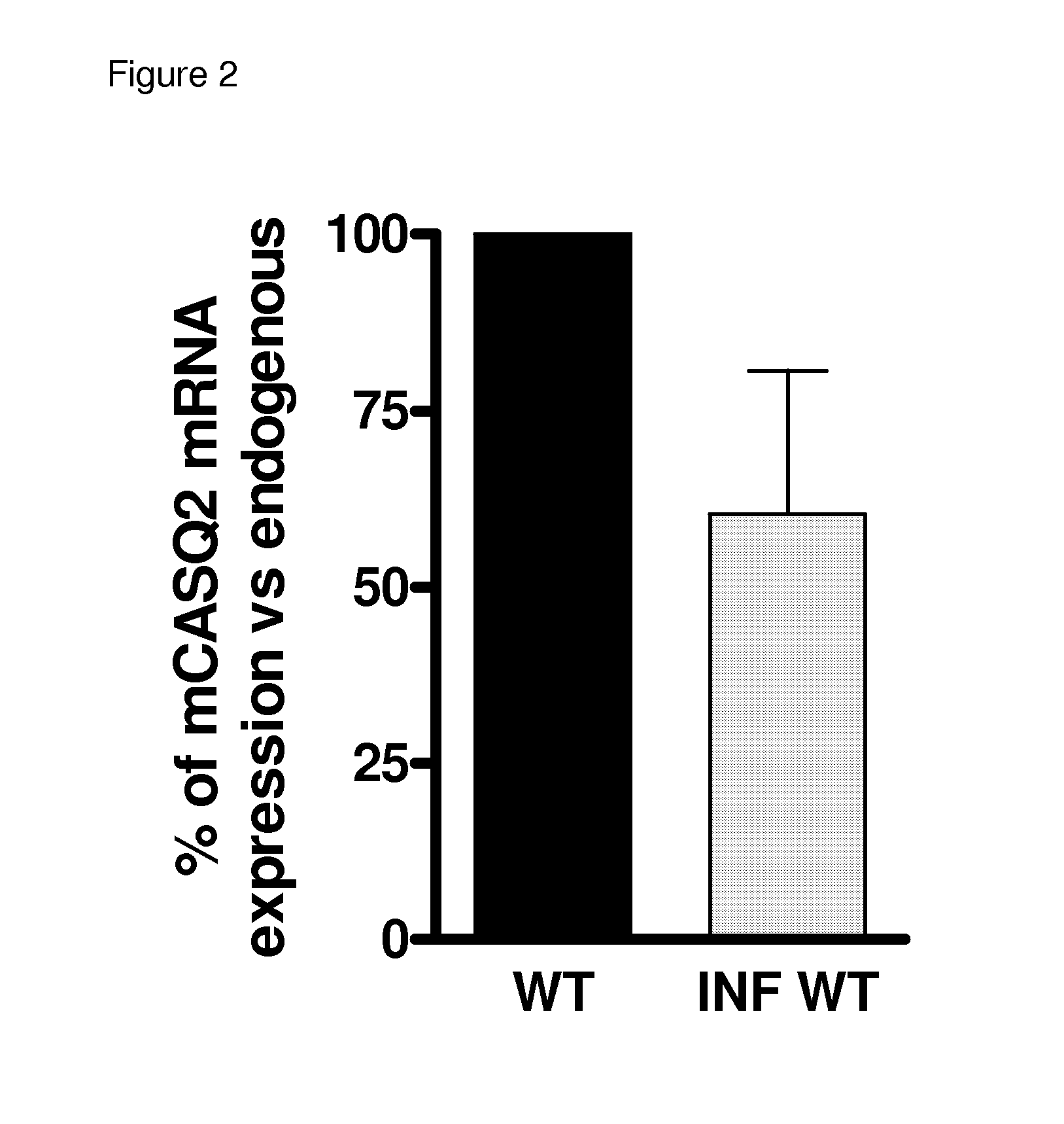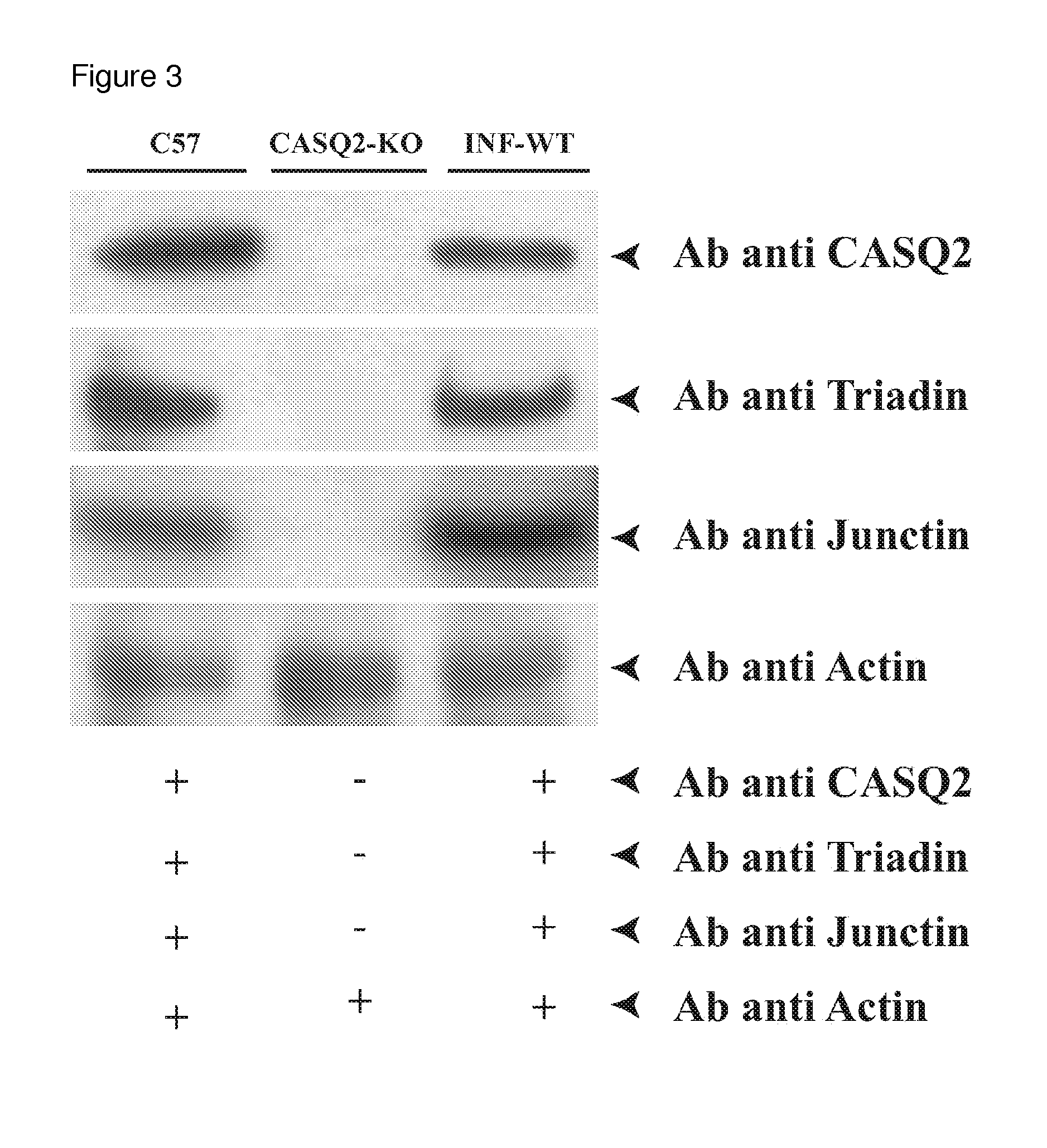Method of gene transfer for the treatment of recessive catecholaminergic polymorphic ventricular tachycardia (CPVT)
a catecholaminergic and polymorphic ventricular technology, applied in the field of gene transfer for the treatment of the recessive catecholaminergic polymorphic ventricular tachycardia, can solve the problems of incomplete response to therapy and less understanding of the pathophysiology of the diseas
- Summary
- Abstract
- Description
- Claims
- Application Information
AI Technical Summary
Benefits of technology
Problems solved by technology
Method used
Image
Examples
example 1
[0037]The DNA of the murine WT CASQ2 gene was cloned into a bi-cistronic (pIRES) eukaryotic expression vector and sub-cloned into the multiple cloning site of pAAV2.1, serotype 9,-CMV-eGFP, containing the CMV promoter and green fluorescent protein as reporter gene (7)
example 2
In Vivo Infection of Cardiac Murine Myocytes Using the AAV2 / 9 Vector For Efficient WT-mCASQ2 Gene Transfer
[0038]We infected, by intraocular and intraperitoneal (I.P.) injection, neonatal (after birth, P2-P3) CASQ2 KO mice using 100 μl of serotype 9 adeno-associated viral (AAV2 / 9) vector containing WT-mCASQ2. The mice were monitored during their development and we did not observe any differences in comparison with the non infected littermates. To evaluate the infection efficiency in the mice, we performed a standard procedure of cardiac myocytes isolation by enzymatic digestion (4). The isolated cells were plated on coverslips and observed with epifluorescent microscope in order to assess the presence and the level of expression of the reporter gene, eGFP. The isolations were performed at 8, 10-12 and 20-30 weeks after infection. Best results were obtained after 20 weeks with a 50-60% of myocytes isolated from infected KO mice expressing the transgene as indicated by eGFP reporter ex...
example 3
Analysis of Expression of AAV2 / 9-WT-mCASQ2 in CASQ2-KO Infected Mice
[0039]While the eGFP signal detection allowed to demonstrate the correct AAV2 / 9-mediated delivery of the transgene (CASQ2 in our case) into cardiac myocytes, the quantification of the expression levels was carried out through a series of in vitro assays on isolated myocytes. RealTime-PCR and immunoblot analysis provided quantification of expression at transcriptional and translational level of the mRNA and proteins. Quantitative RealTime PCR revealed an average of 60% (range 40-80%) as compared with WT normal levels of the murine calsequestrin mRNA in the infected mice (FIG. 2). Based on this encouraging result we than performed Immunoblot analysis in order to verify the correct expression of the cardiac calsequestrin in adult cardiomyocytes isolated from infected CASQ2-KO mice.
[0040]FIG. 3 depicts a typical Western blot experiments following these observations, showing that the viral transduction restored physiolog...
PUM
 Login to View More
Login to View More Abstract
Description
Claims
Application Information
 Login to View More
Login to View More - R&D
- Intellectual Property
- Life Sciences
- Materials
- Tech Scout
- Unparalleled Data Quality
- Higher Quality Content
- 60% Fewer Hallucinations
Browse by: Latest US Patents, China's latest patents, Technical Efficacy Thesaurus, Application Domain, Technology Topic, Popular Technical Reports.
© 2025 PatSnap. All rights reserved.Legal|Privacy policy|Modern Slavery Act Transparency Statement|Sitemap|About US| Contact US: help@patsnap.com



